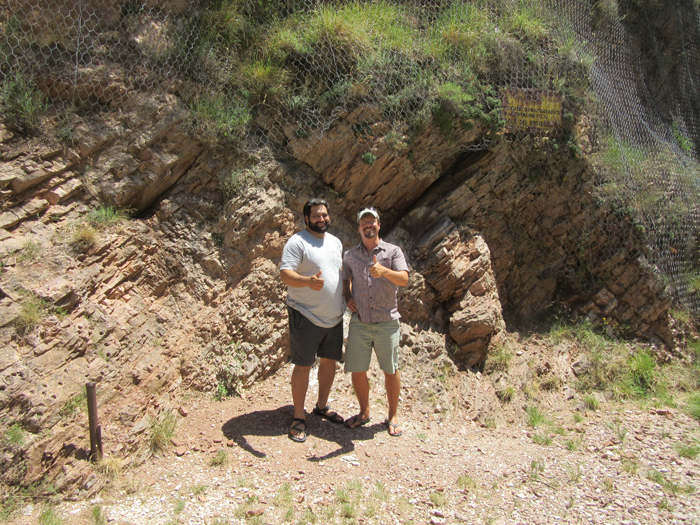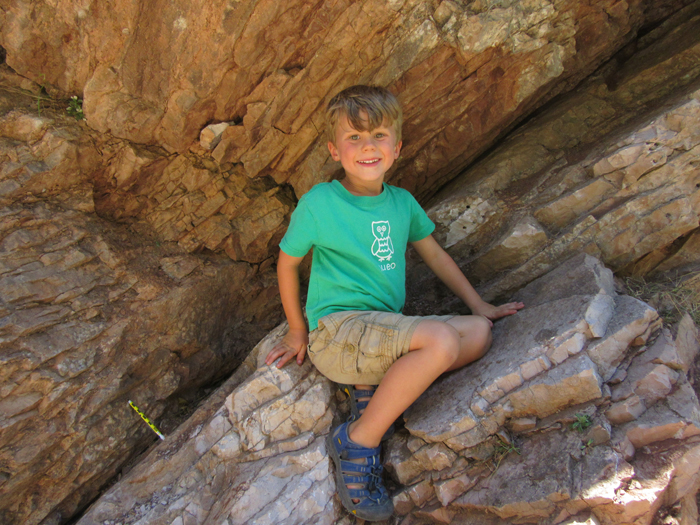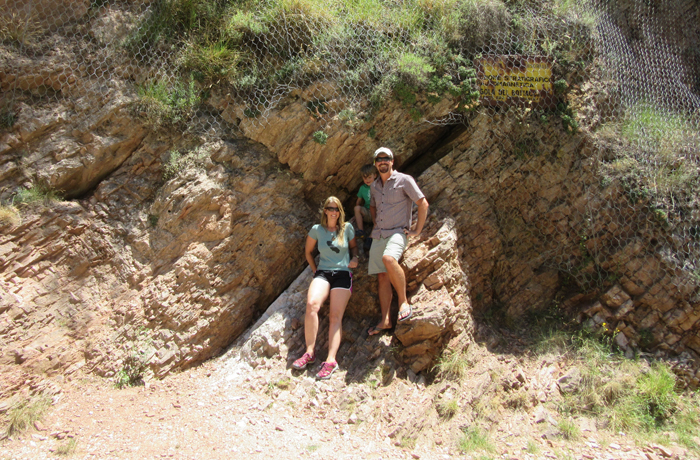An hour ago, I asked if anyone recognized this green book, known among geologists as The Green Book.

It’s in a small roadside cafe, the Osteria del Bottaccione, in Bottaccione Gorge, near Gubbio, Italy. It’s the nearest place for a coffee (1 €) while visiting a famous outcrop. Geologists who visit the gorge sign their names in the book.
Here’s my four-year-old geologist-in-training, etching his name into history:


We were led into the gorge by my friend and former student Alan Pitts (University of Camerino), who brought us to the outcrop that everyone travels there to see:

Here’s the outcrop from the other side of the road, and without Alan and me blocking the view. It’s squeezed in between the road and an aqueduct up the hill. Chain-link fencing covers the slopes above to retard the passage of falling rocks.

The reason this site is worth visiting? It’s the spot where the Cretaceous ends and the Paleogene begins, a major moment in Earth history preserved in a conformable stratigraphic sequence of pelagic limestones (the Scaglia Rossa). A thin seam of clay along the boundary (heavily etched out due to the intense interest of geotourists through the years) was found by Alvarez and Alvarez to be extraordinarily enriched in iridium, leading them to postulate an extraterrestrial impact hypothesis for the end-Cretaceous mass extinction event.

This thin seam is the geological “moment” that the ammonites died out, that the non-avian dinosaurs ceased existing, that the world switched from the Mesozoic to the Cenozoic. This clay seam is the end of an era, literally. It’s a profound moment in geologic time; a rough time for the global biosphere and a warning to those who survived.
It’s also a place where science changed: where the strict uniformitarianism of bygone years was replaced with a brasher, more violent “actualism,” that allowed one-off violent (“catastrophic”) events as major players in the evolution of the planet Earth. Team Alvarez changed the way geoscientists think about the nature of change in the Earth system; armed with compelling data, they pushed the boundaries of our imaginations. It was an inexpressible treat to be able to visit it last summer in person.
It’s not a gorgeous place. Signage alerting passers-by to the importance of the site is unfortunately in a pretty shabby state of repair:

Also, the outcrop has been heavily pockmarked with drill core sampling, leaving a ugly population of holes:


That said, I think anyone with the slightest interest in Earth history would be thrilled to put their hand on that crack between the strata, to contemplate the extraordinary shifts that took place there.
Here, the Littlest Stratigrapher and his stuffed wild boar toy approach the outcrop:

Visiting the K/Pg boundary at Gubbio perhaps meant more to our family than the average geo-family: My wife and I met on a dinosaur paleontology field course in Makoshika State Park, Montana, in the Hell Creek Formation and overlying Fort Union Formation. The boundary between the two? You guessed it: the K/Pg boundary, there marked by a coal seam containing some volcanic ash. We fell in love at the stratigraphic signal of the dinosaur’s demise, and here was an opportunity to revisit that same moment in geological time, in a different country, in a different depositional setting. And: we got to tote along our son this time – in a way for him, it is a sort of homecoming. He likely wouldn’t exist if it weren’t for our particular history with this particular stratigraphic interval.

…And so: this image is going on my family’s Christmas card this year:

“Happy holidays from the dawn of the Cenozoic, from the most extraordinary moment in the past 250 million years!”

For an interesting read on the whole Appenine range I recommend Walter Alverez’s book the Mountains of St. Francis, which covers story of how the mountains came to be including coverage on the Gubbio gorge and thw work on the KT boundary.
Yes. It’s great. I’ve read it too: review here.
Real geotourists don’t take samples.
Good story, we paid homage to the fascinating Gubbio site in our book about Chiczulub. Springer – 2017. Its writing like yours that’s needed today to remedy the ignorance of our political leaders, most of who must have gotten D in science.
Thanks!
That’s a very interesting article, and also very nice indeed by sharing your family-story. I had the privileg to visit the site some years ago, a site rather neglected by the authorities. Nevertheless it is a very strong emotion touching those “witnesses” of the K/T, oops, K/Pg-Extinction.
Excellent share, Callan, it is on my geo-bucket list! Many thanks!!
I live and love this fabulous little city. It has so many interesting sites to visit and see. Hopefully more people will come and visit these amazing sites.
Dear Callan,
Another wonderful post! Thanks for sharing. Happy Holidays!
Great article.
Thanks.
Beautiful family.
Happy Holidays.
Thank you!
A bit late to the party, but this post is what sold a visit to Gubbio for me and my partner.
I’m a Motion Graphic Designer from London who has to research many of the topics I’m tasked to produce personally, and nothing was quite as amazing as knowing there was a KT/K-Pg boundary just two hours from my partner’s family home! It’s really solidified an interest in Geology (and a bit of Palaeontology) if i’m honest! It was a an extremely interesting place to visit.
Sadly we went on a day where the Gubbio Dinosaur museum was closed– much to our disappointment, but the town itself was still wonderful (and the Icecream servings were HUGE from an Englishman’s perspectively!). The park near the boundary is small but fairly interesting. The remains of an aquaduct/dam of sorts make a super place to visit either on your way to/on your way back from the higher portion of the strata.
The pocked holes in the rock from geological studies might’ve been ugly in 2017, but in 2020 (despite the obvious.. ongoing global catastrophes) they’re in full “bloom” with types of hardy succulents, living as if each hole is their own little plant pot.
A truly wonderful destination for anyone with a spark of interest in Geology & Palaeontology.
Thank you & Grazie!
Wonderful photos, Callan! I found Osteria del Bottacione 1.5 km NE of Gubbio on SR 298 using Google Maps and I also found Bottaccione Gorge 1 km NE of Gubbio but I could not match your photos to anything along the road and I searched pretty thoroughly. Maybe there’s something I am misunderstanding? Anyway, this is the Google Maps URL for the location which I believe it should be at but, even considering overgrowth of flora, it does not seem to be a match. Grazie for any assistance.
https://www.google.com/maps/@43.359742,12.5799028,3a,75y,129.1h,77.88t/data=!3m9!1e1!3m7!1sC3KdtUqFmigwnTy1F7APwQ!2e0!7i16384!8i8192!9m2!1b1!2i33?hl=en
Great to see the next generation of young geologists in the making! I’m travelling to Italy next June 2023 for a holiday and hope to visit Gubbio and the KT exposure. It is a little sad to think that the site isn’t looked after better isn’t it? Still , I am going to create a new sign that I hope can be hung in the local cafe where the green book is with a dedication to Alvarez and the thousands of other people who haven’t been able to visit the site. Before retiring I taught geology and geography to secondary aged pupils ( 11yrs to 18 yrs ) in the UK. I will post text and photos on my return
Hello Callan, thanks for the tip on the green books at Gola del Bottaccione. I visited the K-Pg exposure this past August. I posted about the site and included some pictures of the green books on my blog:
https://nwgeology.wordpress.com/2024/01/03/gubbio-italy-i-visited-the-famous-layer-recording-the-66-million-year-old-asteroid-strike-mass-extinction-of-the-dinosaurs-and-nearly-everything-else/
The main change since you were there is the big new interpretive sign in both Italian and English. It was a bucket list thing, and one of the main reasons I went to Italy. Ciao. Dave Tucker, Bellingham, WA
The trip to “the” K-T boundary outcrop and eating at the small roadside cafe, the Osteria del Bottaccione, in Bottaccione Gorge, near Gubbio, Italy, was a highlight to our family trip to Italy. We proudly signed our names in the Green Book (towards the end of book 3). Our family also hiked along the old aqueduct trail which is above the outcrop with the sign. It is a relatively easy trail with great views of the Apennines’ structural bedding and a walk into the surrounding woods.
Your blog and follow up communication before the trip were instrumental to a successful visit to Bottaccione Gorge. I highly recommend reading both T. Rex and the Crater of Doom and The Mountains of Saint Francis, both written by Walter Alvarez. The Mountains of Saint Francis’ geologic descriptions from Rome through the Apennines all the way to the Alps brought so much clarity to the geology as we traveled about Italy.